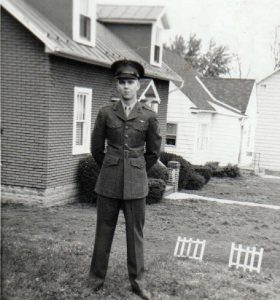Deb Spalding
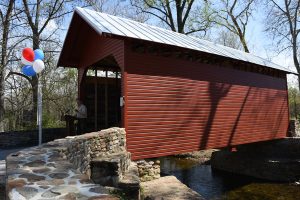 The Roddy Road Covered Bridge is a coveted link to our local history in Northern Frederick County. It is one of three historic covered bridges in the area, along with Loy’s Station and Utica bridges. The forty-foot-long single-lane structure was originally built in the mid-1800s.
The Roddy Road Covered Bridge is a coveted link to our local history in Northern Frederick County. It is one of three historic covered bridges in the area, along with Loy’s Station and Utica bridges. The forty-foot-long single-lane structure was originally built in the mid-1800s.
Last June, it was struck and partially carried away by a box truck. The resulting damage made the bridge unsafe, so it had to be closed. Repairs to the bridge began in October and were completed by Dean Fitzgerald’s Heavy Timber Construction, Inc., in cooperation with the Frederick County Department of Public Works and Frederick County Department of Parks and Recreation.
While the bridge was closed, Frederick County took the opportunity to re-route Roddy Creek Road away from Roddy Creek in order to open space for a new park that includes a playground, walking trail, bathroom, parking area, and a (future) bridge-like pavilion. They also took action to prevent future damage to the bridge by installing a passive over-height warning system that a too-large-to-pass-through-the-bridge vehicle will hit before getting to the bridge.
Several Frederick County officials and staff came out to celebrate the reopening of the bridge and park on Monday, April 17, 2017. Frederick County Public Works Director Chuck Nipe welcomed guests. He extended sincere appreciation to the residents who attended public meetings and provided recommendations about how to avoid future bridge damage incidents. He also thanked several entities, including Jeff Yokum, the bridge neighbor who provided land for the turnaround at the bridge; Fitzgerald Heavy Timber Construction, Inc. employees who rebuilt the bridge; HMF Paving employees who were instrumental in the apprehension of the individual who damaged the bridge; Frederick County Highway Bridge Construction Crew, District 1 Crew, and the sign crew who fabricated and installed the signage and protective devices; Frederick County maintenance personnel who completed the electrical work; and the Transportation Engineering staff who coordinated the project and the reconstruction efforts.
Frederick County Executive Jan Gardner said, “In Frederick County, we are passionate about our historic covered bridges.” She talked about the historic significance of the bridge, and thanked all parties involved in its reconstruction and the formation of the surrounding park.
Other speakers included Frederick County Council President Bud Otis, Frederick County Parks and Recreation Commission Chair Mary Ann Brodie-Ennis, Frederick County Parks and Recreation Director Jeremy Kortright, Frederick County Parks and Recreation Commission members, Thurmont Mayor John Kinnaird, and several other guests and staff.
Dean Fitzgerald, president of Fitzgerald’s Heavy Timber Construction, Inc., the contractors for the project, shared his memories of playing in the creek and on the bridge as a youngster. He said that at a young age he never imagined he would have a part in its reconstruction. He reminded us that we must continue to be vigilant about our covered bridges and our community. “These are blessings we don’t even realize we have.”
Dean remembered Shaeffer Bailey. Bailey was the bridge neighbor who lived in the brick house nearby, and the man who gave the land to Frederick County for Roddy Road Park. He was vigilant in protecting the bridge, taking Dean to task [and surely others] when he was caught throwing mudballs at the bridge. Bailey rallied the community to put the bridge back together in 1992, after it received damage. At the time, it took two days work for community volunteers to repair the bridge.
Dean announced that his company is partnering with Frederick County Parks and Recreation to construct a pavilion. “We want it to be similar to the covered bridge and potentially use some of the timber that was salvaged from the original bridge. The community is invited.”
Jeremy Kortright coordinated the cutting of the ceremonial ribbon. “This is an exciting day for the community,” he expressed, and thanked the parties involved in the restoration of the bridge.
Thurmont Mayor John Kinnaird, reminded us that the bridge opening is eight feet, six inches tall and not every vehicle is going to fit through that opening.
Once the ribbon was cut for the bridge’s official opening, the first to pass through it were people on foot, followed by bicyclists. The first vehicle through was a Chrysler minivan driven by Thurmont resident, Joe Eyler.
Dean Fitzgerald, president of Fitzgerald Heavy Timber Construction, Inc., the contractor for the bridge repair project, is shown as the sun shines on the beautifully completed bridge.
Honored guests and elected officials cut the ribbon to open the reconstructed Roddy Road Historic Covered Bridge.


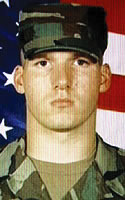 November 29, 2004, was Army Specialist Erik Hayes last day alive. He didn’t know it. The decorated soldier had just turned twenty-four a couple of weeks earlier, and was a young man with dreams. He wanted to attend college and become a veterinarian; but most of all, he wanted to return home to his family.
November 29, 2004, was Army Specialist Erik Hayes last day alive. He didn’t know it. The decorated soldier had just turned twenty-four a couple of weeks earlier, and was a young man with dreams. He wanted to attend college and become a veterinarian; but most of all, he wanted to return home to his family.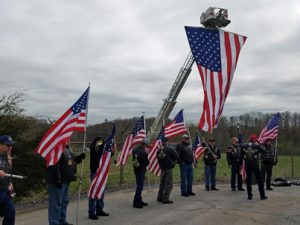 More than one hundred people were at the State Highway Administration building, where Maryland 140 crosses the Monocacy, to take part in the dedication of the bridge sign for the nearby bridge in honor of Hayes. The sign that would be installed at the beginning of the bridge was unveiled, and Hayes’ parents were given miniature versions that they could keep with them.
More than one hundred people were at the State Highway Administration building, where Maryland 140 crosses the Monocacy, to take part in the dedication of the bridge sign for the nearby bridge in honor of Hayes. The sign that would be installed at the beginning of the bridge was unveiled, and Hayes’ parents were given miniature versions that they could keep with them.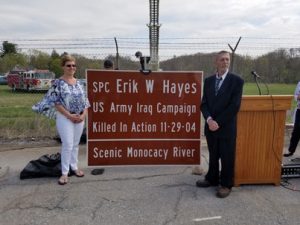
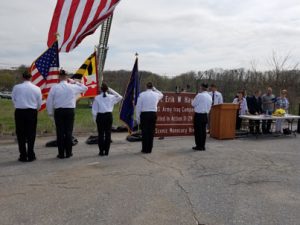
 Just after his first birthday, six-year-old Ben Myers (pictured right) began having hundreds of seizures a day, for over a year, and was diagnosed with a catastrophic form of epilepsy caused by a rare mutation of the SCN2A gene. There is currently no cure for SC2NA. Due to the seizures, Ben can no longer talk, but he can give the best hugs! Please come out and support this sweet little boy and his family and help fight for a cure for SCN2A. All proceeds from the tournament go to Ben and his family to cover therapy, equipment, and other medical expenses not covered by insurance.
Just after his first birthday, six-year-old Ben Myers (pictured right) began having hundreds of seizures a day, for over a year, and was diagnosed with a catastrophic form of epilepsy caused by a rare mutation of the SCN2A gene. There is currently no cure for SC2NA. Due to the seizures, Ben can no longer talk, but he can give the best hugs! Please come out and support this sweet little boy and his family and help fight for a cure for SCN2A. All proceeds from the tournament go to Ben and his family to cover therapy, equipment, and other medical expenses not covered by insurance. On Friday evening, May 26, 2017, the Myersville-Wolfsville Area Historical Society will sponsor a free PowerPoint presentation, exploring the rich history of the presidential retreat at Camp David.
On Friday evening, May 26, 2017, the Myersville-Wolfsville Area Historical Society will sponsor a free PowerPoint presentation, exploring the rich history of the presidential retreat at Camp David.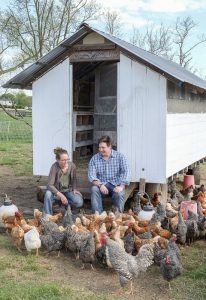 Wild Song Farm operates on a historic property known as Father’s Farewell on Moser Road in Thurmont. In 1738, the farm was part of the 500-acre Taylor’s Lot, owned by Johann Jacob Weller. Fifty acres were later passed to his stepson, John Henry Firor, who is believed to have built the beautiful stone home on the property, from 1765 to 1780. The property earned its name, Father’s Farewell, when son John Leonard Firor inherited it from his father, who moved west. The farm stayed in the Firor family until about 1872.
Wild Song Farm operates on a historic property known as Father’s Farewell on Moser Road in Thurmont. In 1738, the farm was part of the 500-acre Taylor’s Lot, owned by Johann Jacob Weller. Fifty acres were later passed to his stepson, John Henry Firor, who is believed to have built the beautiful stone home on the property, from 1765 to 1780. The property earned its name, Father’s Farewell, when son John Leonard Firor inherited it from his father, who moved west. The farm stayed in the Firor family until about 1872. For entertainment, Emmitsburg resident Rick Oleszczuk, along with his wife, Erin, and children, were once trapped in an underground playground in Nashville. They barely escaped, and decided that they had so much fun that they wanted to trap other people. That’s why they opened Escape Gettysburg.
For entertainment, Emmitsburg resident Rick Oleszczuk, along with his wife, Erin, and children, were once trapped in an underground playground in Nashville. They barely escaped, and decided that they had so much fun that they wanted to trap other people. That’s why they opened Escape Gettysburg.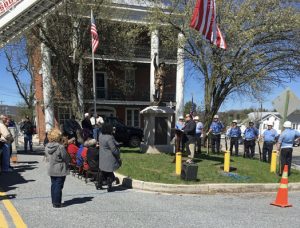 A solemn, respectful crowd gathered in Emmitsburg on Saturday, April 8, 2017, for the ceremony to commemorate the 100th anniversary of the United States’ entrance into World War I on April 6, 1917.
A solemn, respectful crowd gathered in Emmitsburg on Saturday, April 8, 2017, for the ceremony to commemorate the 100th anniversary of the United States’ entrance into World War I on April 6, 1917. A large crowd gathered in Emmitsburg on April 8, 2017, to watch as two identical rooms, set up in a special apparatus in the parking lot of the Frederick County Fire & Rescue Museum/National Fire Heritage Center (NFHC), were set on fire. The room with the fire sprinkler protection sustained some damage, but the room without this protection was completely destroyed. First responders from the Vigilant Hose Company and the Emmitsburg Volunteer Ambulance Company participated in support of the demonstration, which was coordinated with the governments of the Town of Emmitsburg and Frederick County.
A large crowd gathered in Emmitsburg on April 8, 2017, to watch as two identical rooms, set up in a special apparatus in the parking lot of the Frederick County Fire & Rescue Museum/National Fire Heritage Center (NFHC), were set on fire. The room with the fire sprinkler protection sustained some damage, but the room without this protection was completely destroyed. First responders from the Vigilant Hose Company and the Emmitsburg Volunteer Ambulance Company participated in support of the demonstration, which was coordinated with the governments of the Town of Emmitsburg and Frederick County.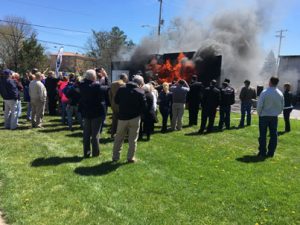


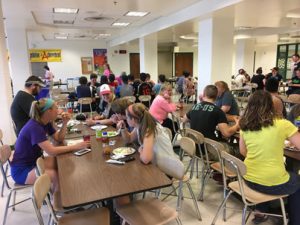


 Members of the Pirates Tee-Ball Team are shown exiting the field following the opening day ceremony.
Members of the Pirates Tee-Ball Team are shown exiting the field following the opening day ceremony. Wyatt Black throws the first pitch to open the 2017 Thurmont Little League season of baseball.
Wyatt Black throws the first pitch to open the 2017 Thurmont Little League season of baseball.
